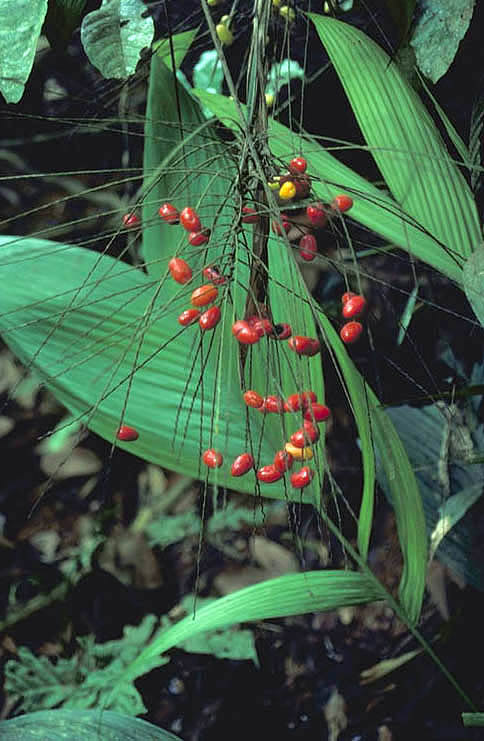- Acanthophoenix
- Acrocomia
- Actinokentia
- Actinorhytis
- Adonidia
- Aiphanes
- Allagoptera
- Ammandra
- Aphandra
- Archontophoenix
- Areca
- Arenga
- Asterogyne
- Astrocaryum
- Attalea
- Bactris
- Balaka
- Barcella
- Basselinia
- Beccariophoenix
- Bismarckia
- Borassodendron
- Borassus
- Brassiophoenix
- Burretiokentia
- Butia
- Calamus
- Calyptrocalyx
- Calyptrogyne
- Calyptronoma
- Carpentaria
- Carpoxylon
- Caryota
- Ceratolobus
- Ceroxylon
- Chamaedorea
- Chamaerops
- Chambeyronia
- Chelyocarpus
- Chuniophoenix
- Clinosperma
- Coccothrinax
- Cocos
- Corypha
- Cryosophila
- Cyphokentia
- Cyphophoenix
- Cyphosperma
- Daemonorops
- Deckenia
- Desmoncus
- Dictyocaryum
- Drymophloeus
- Dypsis
- Elaeis
- Eleiodoxa
- Eremospatha
- Eugeissona
- Euterpe
- Gaussia
- Geonoma
- Guihaia
- Hedyscepe
- Hemithrinax
- Howea
- Hyophorbe
- Hyospathe
- Hyphaene
- Iriartea
- Iriartella
- Itaya
- Jailoloa
- Johannesteijsmannia
- Juania
- Jubaea
- Jubaeopsis
- Kentiopsis
- Kerriodoxa
- Korthalsia
- Laccospadix
- Laccosperma
- Lanonia
- Latania
- Lemurophoenix
- Leopoldinia
- Lepidocaryum
- Lepidorrhachis
- Leucothrinax
- Licuala
- Linospadix
- Livistona
- Lodoicea
- Lytocaryum
- Manicaria
- Manjekia
- Marojejya
- Masoala
- Mauritia
- Mauritiella
- Maxburretia
- Medemia
- Metroxylon
- Myrialepis
- Nannorrhops
- Nenga
- Neonicholsonia
- Neoveitchia
- Nephrosperma
- Normanbya
- Nypa
- Oenocarpus
- Oncocalamus
- Oncosperma
- Orania
- Oraniopsis
- Parajubaea
- Pelagodoxa
- Phoenicophorium
- Phoenix
- Pholidocarpus
- Pholidostachys
- Physokentia
- Phytelephas
- Pigafetta
- Pinanga
- Plectocomia
- Plectocomiopsis
- Podococcus
- Pogonotium
- Ponapea
- Prestoea
- Pseudophoenix
- Ptychococcus
- Ptychosperma
- Raphia
- Ravenea
- Reinhardtia
- Retispatha
- Rhapidophyllum
- Rhapis
- Rhopalostylis
- Roscheria
- Roystonea
- Sabal
- Sabinaria
- Salacca
- Saribus
- Satakentia
- Satranala
- Schippia
- Sclerosperma
- Socratea
- Solfia
- Sommieria
- Syagrus
- Tahina
- Tectiphiala
- Thrinax
- Trachycarpus
- Trithrinax
- Veitchia
- Verschaffeltia
- Voanioala
- Wallaceodoxa
- Wallichia
- Welfia
- Wendlandiella
- Wettinia
- Wodyetia
- Zombia
- x Jubautia splendens
- ?? Acoelorrhaphe
- ?? Bentinckia
- ?? Brahea
- ?? Clinostigma
- ?? Colpothrinax
- ?? Copernicia
- ?? Cyrtostachys
- ?? Dictyosperma
- ?? Dransfieldia
- ?? Heterospathe
- ?? Hydriastele
- ?? Iguanura
- ?? Incertae sedis & excluded names
- ?? Loxococcus
- ?? Micronoma
- ?? Paripon
- ?? Pritchardia
- ?? Rhopaloblaste
- ?? Serenoa
- ?? Washingtonia

Distribution
Map uses TDWG level 3 distributions (https://github.com/tdwg/wgsrpd)
Costa Rica to Ecuador, below 1200 m elevation. Common in somewhat seasonal tropical moist forest W of the Andes and sometimes dominant in the shrub layer. (Borchsenius F., Borgtoft-Pedersen H. and Baslev H. 1998. Manual to the Palms of Ecuador. AAU Reports 37. Department of Systematic Botany, University of Aarhus, Denmark in collaboration with Pontificia Universidad Catalica del Ecuador)A
Description
- Understorey palm. Stems clustered, to 4 m tall and 3.5 cm in diameter, rarely taller. Leaves with blade to 150 cm long, divided into 6-32 unequal to nearly equal, sigmoid to falcate pinnae on each side, the central ones 40-60 x 1.5-40 cm; leaf axis green and smooth. Inflorescence once branched, to 80 cm long, with up to 75, long and slender, spreading branches. Flowers minute, yellow, arranged in linear groups of 5-13 male flowers above a basal female one. Fruits ellipsoid, ca. 2 cm long, yellow to orange, turning bright red at full maturity, very soft when ripe. (Borchsenius F., Borgtoft-Pedersen H. and Baslev H. 1998. Manual to the Palms of Ecuador. AAU Reports 37. Department of Systematic Botany, University of Aarhus, Denmark in collaboration with Pontificia Universidad Catalica del Ecuador)A
Use Record
- Synechanthus warscewiczianus H.Wendl.: Cayapas. Inhabited by evil spirits. (Barfod, A. & H. Balslev 1988: The use of palms by the Cayapas and Coaiqueres on the Coastal plain of Ecuador)
Use Category Use Sub Category Plant Part Human Group Ethnic Group Country Cultural Recreational Entire plant Indigenous Cayapa Ecuador - Synechanthus warscewiczianus H.Wendl.: Dyes for textiles (Synecanthus warscewiczianus, Chamaedorea sp. Geonoma sp.). (…). The Cayapas (…), and believe it is inhabited by evil spirits from the forest. They do no use it but say that birds are fond of its fruits. The Colorados at Santo Domingo (…), and prepare a dye by macerating the leaves in cold water. (Balslev, H., and A. Barfod 1987: Ecuadorean palms- an overview)
Use Category Use Sub Category Plant Part Human Group Ethnic Group Country Cultural Dyes Entire leaf Indigenous Tsáchila Ecuador Cultural Ritual Entire plant Indigenous Cayapa Ecuador - Synechanthus warscewiczianus H.Wendl.: Fruits are edible when boiled. (Borchsenius F., Borgtoft-Pedersen H. and Baslev H. 1998. Manual to the Palms of Ecuador. AAU Reports 37. Department of Systematic Botany, University of Aarhus, Denmark in collaboration with Pontificia Universidad Catalica del Ecuador)
Use Category Use Sub Category Plant Part Human Group Ethnic Group Country Human Food Food Fruits Not identified N/A Ecuador - Synechanthus warscewiczianus H.Wendl.: La madera se usa para la construcción de viviendas, el tronco se usa como polín y para hacer el palo de la escoba, la madera se vende. (Marchan, N. 2001: Etnobotánica cuantitativa de una comunidad Chachi de la Provincia de Esmeraldas, Ecuador)
Use Category Use Sub Category Plant Part Human Group Ethnic Group Country Utensils and Tools Labour tools Stem Indigenous Cayapa Ecuador Construction Houses Stem Indigenous Cayapa Ecuador Utensils and Tools Domestic Stem Indigenous Cayapa Ecuador - Synechanthus warscewiczianus H.Wendl.: Uso Colorante. Las hojas jóvenes maceradas se envuelve en algodón y se tintura al cabo de dos días de color negro, morado. (Cerón, C.E., C. Montalvo, A. Calazacón et al. 2004: Etnobotánica Tsáchila, Pichincha-Ecuador)
Use Category Use Sub Category Plant Part Human Group Ethnic Group Country Cultural Dyes Entire leaf Indigenous Tsáchila Ecuador
- Log in to post comments

